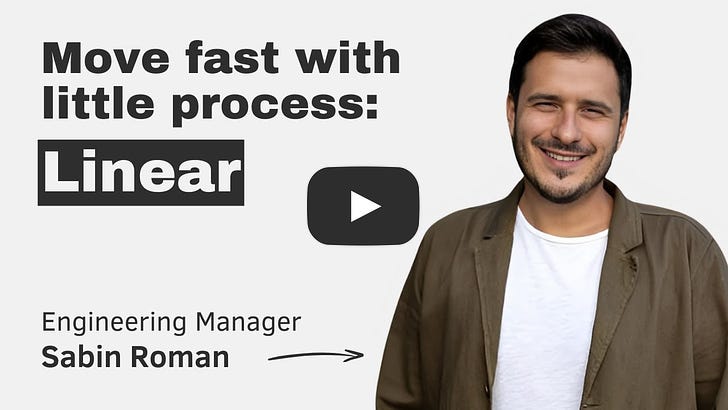|
 |
|
Linear: move fast with little process (with first engineering manager Sabin Roman)
The project management and issue tracking tool is wildly popular within startups and scaleups. Their 25-person eng team ships rapidly, with high-quality, while working full-remote. How do they do it?
Listen now on Apple, Spotify, and YouTube.
Brought to you by:
• Launch Darkly — a platform for high-velocity engineering teams to release, monitor, and optimize great software.
• Sevalla — Deploy anything from preview environments to Docker images.
• WorkOS — The modern identity platform for B2B SaaS.
—
Linear is a small startup with a big impact: 10,000+ companies use their project and issue-tracking system, including 66% of Forbes Top 50 AI companies. Founded in 2019, the company raised $52M in funding and is profitable, and full-remote. How did they pull this off with just 25 engineers?
On today’s episode of The Pragmatic Engineer, I’m joined by fellow Uber alum, Sabin Roman, now the first Engineering Manager at Linear. Linear, known for its powerful project and issue-tracking system, streamlines workflows throughout the product development process.
In our conversation today, Sabin and I compare building projects at Linear versus our experiences at Uber. He shares insights into Linear’s unique approaches, including:
How Linear handles internal communications
The “goalie” program to address customer concerns and Linear’s zero bug policy
How Linear keeps teams connected despite working entirely remotely
An in-depth, step-by-step walkthrough of a project at Linear
Linear’s focus on quality and creativity over fash shipping
Titles at Linear, Sabin’s learnings from Uber, and much more!

Takeaways
My biggest takeaways from this conversation:
1. Linear has a preference for creativity over process – when the goal is creativity! Linear is intentionally light on engineering processes when they build new products: their goal is to communicate using “principles” rather than “guidebooks.” The company manages to do this thanks to a mix of hiring engineers with strong product skills and still being a small enough company (60 people and 25 engineers at the time of writing).
2. Full remote is hard – especially for managers! And yet, there are payoffs to this approach. Sabin has been managing a full-remote team for two years, and this is how he puts it:
“It’s harder for managers to manage remote teams. It just is. It’s harder to build that trust and that connection. To get a pulse on what troubles them and what motivates them. But ultimately, my job as a manager is not to make my life easier.
I really wish that more managers would be more open to working remotely, because it does make your team’s life better. Your team can focus better. It allows flexibility.”
3. Starting a zero-bug policy is hard, but it’s much easier to continue once in place. Sabin admits that he was initially skeptical about whether it was feasible to implement an actual zero-bug policy.
However, after the initial few months of fixing existing bugs, he now sees that it works, and it works without overloading engineers. Part of the success seems to be in giving engineers the freedom to both decide when a bug should be considered a bug – and giving them autonomy in deciding how they use their time.
4. Despite working at Uber for 7 years, Sabin brought relatively few approaches from this large company to Linear. Reflecting on why Uber and Linear are so different: a lot of it comes down to size, and the effectiveness of communication with a smaller team. As Sabin put it:
“You can’t underestimate the difference it makes for still being a startup. That takes away a lot of the challenges.”
This is a good reminder for anyone moving from Big Tech to a smaller company: don’t expect the same processes to work! We covered more on this topic in the deepdiveHiring software engineers from Big Tech.
Timestamps
(00:00) Intro
(01:41) Sabin’s background
(02:45) Why Linear rarely uses e-mail internally
(07:32) An overview of Linear's company profile
(08:03) Linear’s tech stack
(

